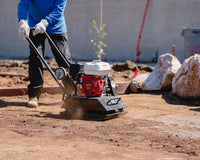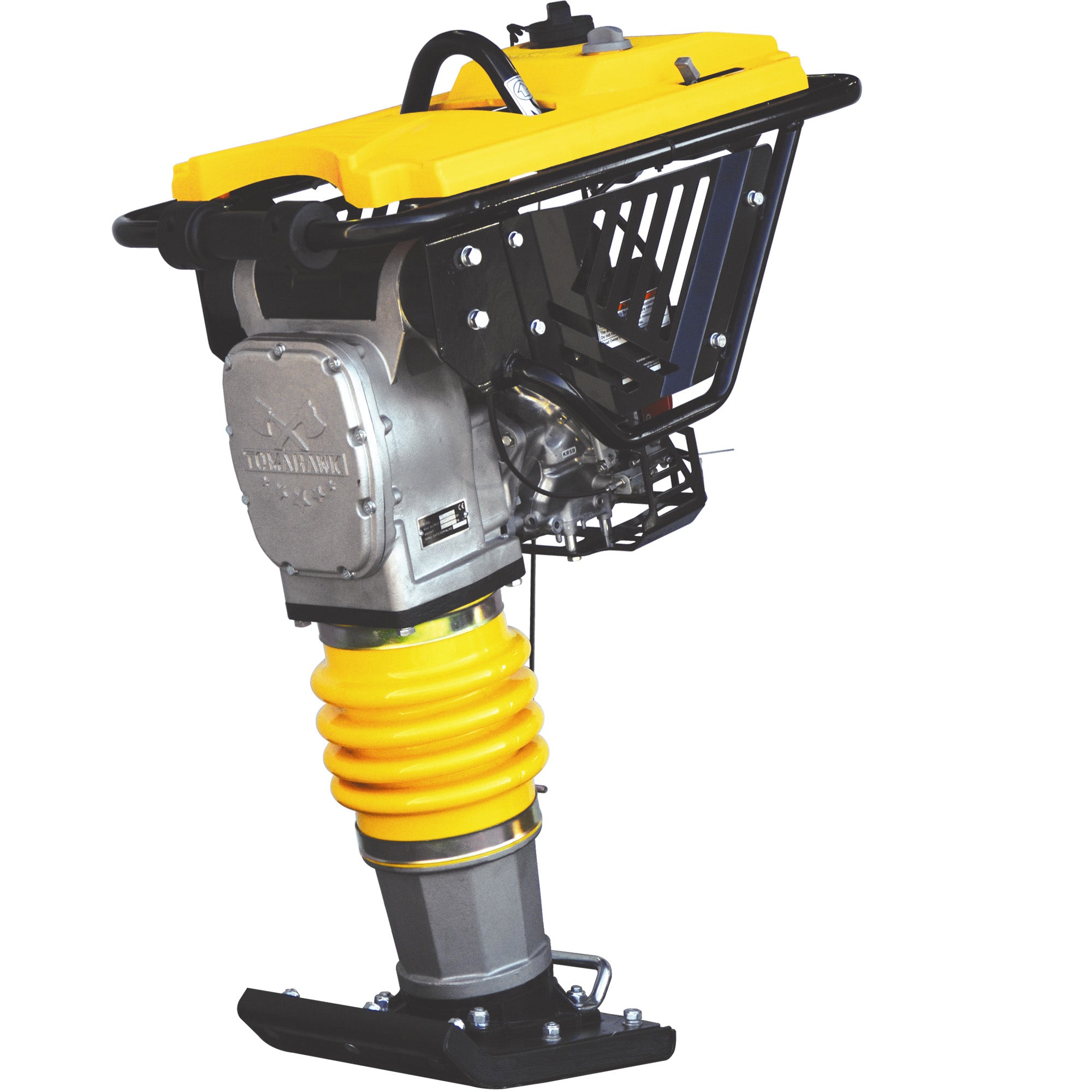The soil underneath construction sites is the groundwork for any construction project. Crucial for providing support for foundations, buildings, pavements, and other structures, soil compaction is an essential piece to safe and successful jobs.
There are multiple ways in which soil can be compacted. Depending on the type of soil compaction required, there are a variety of compaction tools that will help you achieve the desired compaction level.
Tamping Rammer (Gas Engine)
Gas powered, walk behind tamping rammers are some of the most commonly used pieces of equipment for soil compaction. From the most industrial jobsites, to the Do-It-Yourself homeowner, you will find this type of machinery on just about any job that requires soil compaction. A tamping rammer is ideal for cohesive soil compaction, and its size and maneuverability makes it great for tight corners or compacting near a wall. Examples of cohesive soils would be clay or silt. The typical shoe size you will find on a tamping rammer is 11 x 13 “. However, there are other common attachments such as an 8” or 6” shoe. The shoe refers to the plate at the bottom of the equipment that is in direct contact with the soil. Sizes and weight on tamping rammers can also vary. Depending on your budget and jobsite requirements, you may want to invest in a heavier tamping rammer. A typical tamping rammer that can deliver 3,350 lbs per square foot of compaction force will be sufficient to reach up to 100% compaction density with proper soil moisture content, although it will take several passes with the equipment. The Tomahawk Power TR68H Tamping Rammer is one of the highest value rammers for this product category in the market.
Use On: Soil and trenches with dirt, mud, and clay.
Tamping Rammer (Electric Engine)
Some jobsite conditions make it difficult, or blatantly dangerous to use gasoline engine driven tamping rammers. Although they are much more rare, some construction crews will rent or purchase electrically driven walk behind tamping rammers. Depending on the jobsite, you will either need a generator or electrical outlet that can handle the needs of the electric motor. Some rammers are also battery-powered.
Use On: Soil and trenches with dirt, mud, and clay.
Forward Plate Compactor, Vibe Plate
The second most common type of equipment for soil compaction would be the plate compactor, or as it is also commonly referred to as, a vibe plate. Unlike the walk behind tamping rammers, which are ideal for cohesive soil compaction (silt, clay), plate compactors are ideal for granular soil compaction. Examples of granular soil compaction would be gravel, sand, or dirt with a lot of aggregate material. The high frequency vibration that is delivered by the exciter box of the plate compactor helps to eliminate any air pockets within the soil. While there are several different styles of plate compactors, forward plate compactors are typically the least expensive, and easily loaded into a truck by 2-3 people. Unlike reversible plate compactors, forward plate compactors are designed to operate in one direction, and if further passes are needed, the operator must fully turn the unit to continue. An example of a forward plate compactor would be the Tomahawk Power TPC80 Vibratory Plate Compactor Tamper.
Use On: Gravel, sand, pavers, and small asphalt jobs.

Reversible Plate Compactor
Reversible plate compactors, unlike the forward plate compactors that have been discussed, can change direction without forcing the operator to turn the machine around. This can be critical for jobsites where there is little space, and if you find yourself working in a trench. Reversible plate compactors also tend to be much heavier than forward plate compactors, and deliver a higher compaction force. An example of a reversible plate compactor would be the Tomahawk Power TPC170 Honda Reverse Hydraulic Plate Compactor.
Use On: Gravel, retaining walls, deep compaction, and tight spaces.
Asphalt Plate Compactor
An example of an asphalt plate compactor would be a Tomahawk Power TPC90 Honda Vibratory Plate Compactor forward plate compactor with a water tank. Water tanks are used to help prevent the freshly laid asphalt from sticking to the plate of the compactor. The vibrations that are delivered by the exciter box permeate through the machine to drip out the water from the tank in front of the plate compactor as its running.
Use On: Asphalt

Ride-On Roller
For more industrial jobs, or for large areas of land, ride on rollers are ideal for soil compaction. These can range greatly in size, but generally the smallest one you will find weighs about 1 ton. Much like a plate compactor, high frequency is delivered by either a single, or double drums. As the name suggests, operators drive these units from a seated position. These can be used for either asphalt or soil compaction, and are often seen on jobsites for road and highway builders.
Use On: Asphalt and foundation work.

Walk-Behind Roller
These units are typically smaller than ride on rollers, yet slight bigger than reversible plate compactors. It is similar to a ride on roller in that it uses 1-2 vibrating drums to compact the soil or asphalt, yet it is similar to a reversible or forward plate compactor because the operator has to walk behind the unit. Again, many road building, and commercial grade projects utilize this type of compacting machinery.
Use On: Small patchwork, asphalt, and public utilities.

Sheep’s Foot Attachment
Unlike the other equipment described in this article, this is an attachment that must be added to an excavator in order to operate. This is commonly used by construction crews doing pipeline repairs or new construction. It is ideal for deep trenches, and when an excavator is being used on a jobsite for other purposes, it can easily throw on this attachment and help with cohesive soil compaction.
Use On: Soil, large mud areas, cohesive soil.

Excavator Vibrating Plate Attachment
This is another type of attachment for an excavator. Unlike the sheep’s foot attachment, the vibrating plate attachment delivers a high frequency vibration. One way to think about this unit is the plate compactor version of an excavator attachment. This attachment is ideal for granular soil compaction.
Use On: Large jobs with gravel and hard-to-reach areas.

Hand Tamper
Some people just want to keep it simple. This is about as rudimentary as it gets for soil compaction, but it is also by far the cheapest. These are ideal for small home projects, and not for a professional construction jobsite.
Use On: Small home projects.

Without proper soil compaction, structures cannot be fully supported. It's important to choose the right soil compaction method for the job, or else you could end up with detrimental results.

Glossary
Subgrade - The underlying layer of soil which serves as a foundation for the surface materials.
Cohesive Soils - Clays and silts that stick together due to their moisture content.
Granular Soils - Sand and gravel, which rely on friction for stability.
Compaction Depth - The thickness of the soil layer that equipment can effectively compact.
Lift Thickness - The depth of soil laid before it is compacted, important for achieving desired compaction levels.
Amplitude - The height of the vibratory wave generated by the compactor, affecting how deep the vibrations reach.
Frequency - The speed of the vibratory cycle, important for effective soil compaction.
Centrifugal Force - The force applied outward by the compactor, crucial for achieving soil compaction.
Maneuverability - How easily equipment can be moved or adjusted during operation.
Durability - The ability of the equipment to withstand wear and tear during repeated use.














1 comment
Mamoeketsi Merriam
Thanks for information